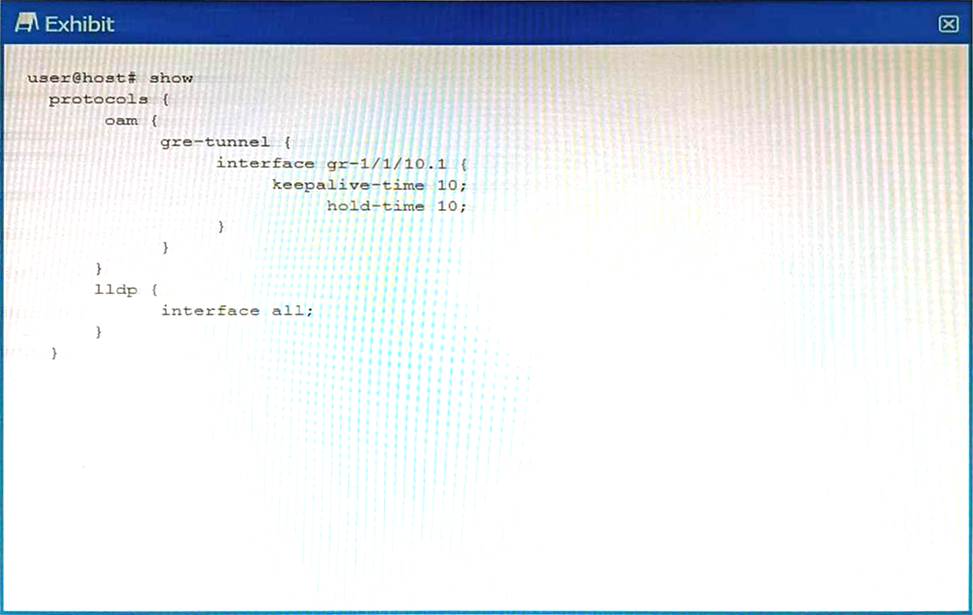- All Exams Instant Download
Referring to the exhibit, what is the problem?
Exhibit

You have configured a GRE tunnel. To reduce the risk of dropping traffic, you have configured a keepalive OAM probe to monitor the state of the tunnel; however, traffic drops are still occurring.
Referring to the exhibit, what is the problem?
A . For GRE tunnels, the OAM protocol requires that the BFD protocols also be used.
B . The "event link-adjacency-loss" option must be set.
C . LLDP needs to be removed from the gr-1/1/10.1 interface.
D . The hold-time value must be two times the keepalive-time value
Answer: D
Explanation:
A keepalive OAM probe is a mechanism that can be used to monitor the state of a GRE tunnel and detect any failures in the tunnel path. A keepalive OAM probe consists of sending periodic packets from one end of the tunnel to the other and expecting a reply. If no reply is received within a specified time, the tunnel is considered down and the line protocol of the tunnel interface is changed to down1.
To configure a keepalive OAM probe for a GRE tunnel, you need to specify two parameters: the keepalive-time and the hold-time. The keepalive-time is the interval between each keepalive packet sent by the local router. The hold-time is the maximum time that the local router waits for a reply from the remote router before declaring the tunnel down2.
According to the Juniper Networks documentation, the hold-time value must be two times the keepalive-time value for a GRE tunnel2. This is because the hold-time value must account for both the round-trip time of the keepalive packet and the processing time of the remote router. If the hold-time value is too small, it may cause false positives and unnecessary tunnel flaps.
In the exhibit, the configuration shows that the keepalive-time is set to 10 seconds and the hold-time
is set to 15 seconds for the gr-1/1/10.1 interface. This means that the local router will send a keepalive packet every 10 seconds and will wait for 15 seconds for a reply from the remote router. However, this hold-time value is not two times the keepalive-time value, which violates the recommended configuration. This may cause traffic drops if the remote router takes longer than 15 seconds to reply.
Therefore, option D is correct, because the hold-time value must be two times the keepalive-time value for a GRE tunnel. Option A is incorrect, because BFD is not required for GRE tunnels; BFD is another protocol that can be used to monitor tunnels, but it is not compatible with GRE keepalives3. Option B is incorrect, because the “event link-adjacency-loss” option is not related to GRE tunnels; it is an option that can be used to trigger an action when a link goes down4. Option C is incorrect, because LLDP does not need to be removed from the gr-1/1/10.1 interface; LLDP is a protocol that can be used to discover neighboring devices and their capabilities, but it does not interfere with GRE tunnels5.
Reference:
1: Configuring Keepalive Time and Hold time for a GRE Tunnel Interface 2: keepalive | Junos OS |
Juniper Networks 3: Configuring Bidirectional Forwarding Detection 4: event link-adjacency-loss |
Junos OS | Juniper Networks 5: Understanding Link Layer Discovery Protocol
Latest JN0-351 Dumps Valid Version with 110 Q&As
Latest And Valid Q&A | Instant Download | Once Fail, Full Refund
Subscribe
Login
0 Comments
Inline Feedbacks
View all comments

